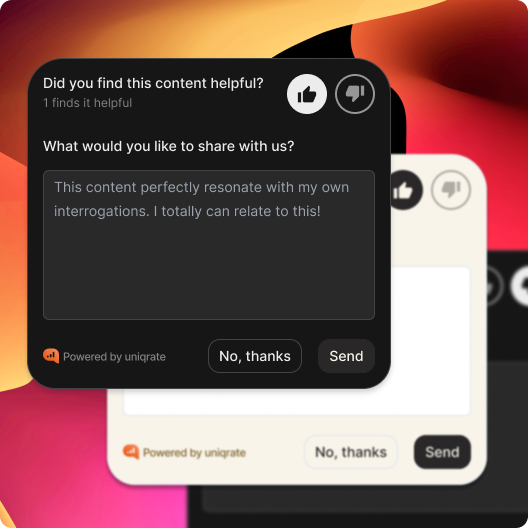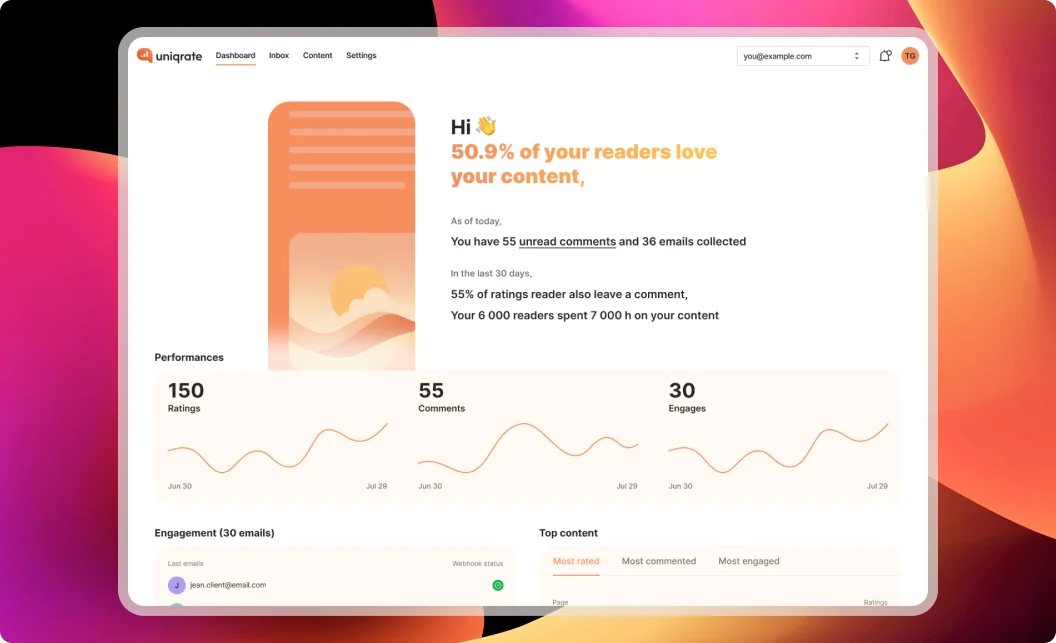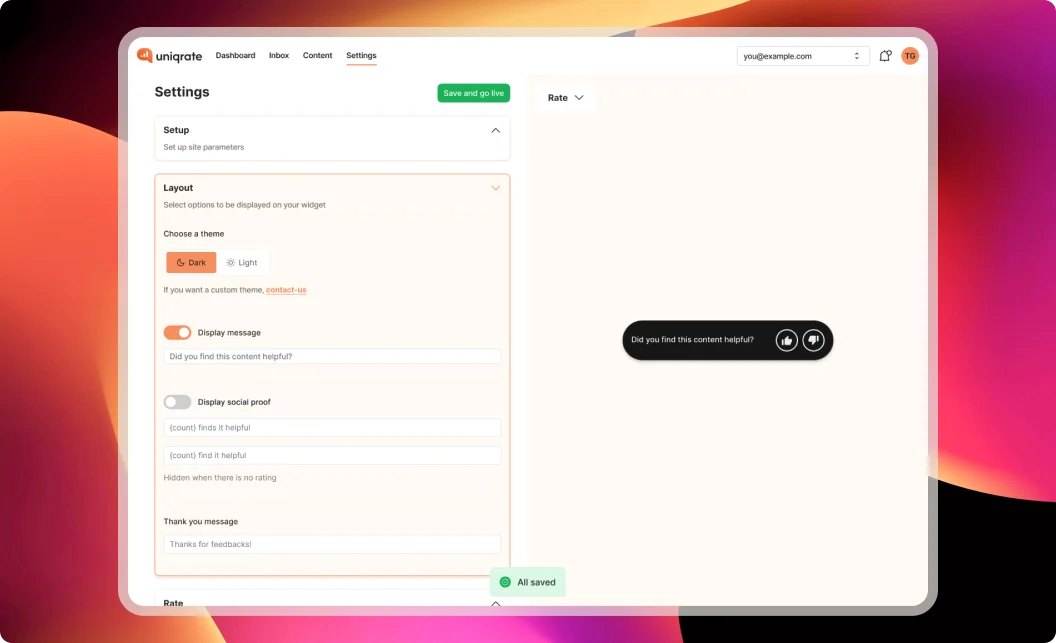Reader engagement is the heartbeat of any successful blog. It’s what transforms casual visitors into loyal followers, improves your site’s SEO performance, and drives conversions. But tracking engagement can seem daunting if you’re not sure which metrics to focus on or how to analyze them effectively.
This comprehensive guide will delve deep into the essential blog engagement metrics you need to track, why they matter, and how you can use them to enhance your content strategy. By the end of this article, you’ll have a clear roadmap for optimizing your blog's engagement and retaining your audience.
What is reader engagement, and why does it matter?
Reader engagement is a measure of how actively your audience interacts with your blog content. It goes beyond surface-level metrics like page views, focusing instead on meaningful actions such as how much of your content readers consume, how long they stay on your site, and whether they interact with elements like links or feedback forms.
The benefits of high reader engagement:
- Improved SEO performance: Search engines like Google prioritize content that keeps users engaged. Metrics such as low bounce rates and high time-on-page contribute to higher rankings.
- Audience retention: Engaged readers are more likely to return, building a loyal community around your blog.
- Increased conversions: Whether it’s signing up for a newsletter, purchasing a product, or sharing your content, engaged readers are more likely to take these actions.
To measure engagement effectively, you need to focus on the right metrics.
Essential blog engagement metrics to track
1. Time on page
Time on page is one of the most straightforward yet insightful engagement metrics. It measures how long a visitor spends on a specific page, indicating whether your content is holding their attention.
Why it matters:
A longer time on page suggests that readers find your content valuable and are taking the time to consume it. Conversely, a short time on page may indicate that your content isn’t meeting expectations or is difficult to read.
How to improve:
- Use storytelling techniques: Create a narrative flow that keeps readers engaged.
- Break up text: Use bullet points, subheadings, and shorter paragraphs to make content scannable.
- Add multimedia: Include images, infographics, or videos to make your posts more dynamic.
2. Bounce rate
Bounce rate measures the percentage of visitors who leave your site after viewing only one page. A high bounce rate often indicates that your blog isn’t engaging enough to encourage readers to explore further.
Why it matters:
Lowering your bounce rate can improve SEO rankings and help you build a deeper connection with readers.
How to improve:
- Internal linking: Add links to related posts within your content to guide readers to explore more.
- Clear navigation: Ensure your site is easy to browse and visually appealing.
- Strong calls-to-action (CTAs): Encourage readers to subscribe, comment, or check out other articles.
3. Scroll depth
Scroll depth tracks how far down the page visitors scroll, showing you how much of your content they’re consuming.
Why it matters:
If readers aren’t reaching the bottom of your posts, it could indicate that your content isn’t engaging or is too lengthy.
How to improve:
- Get to the point: Deliver key information early in the post.
- Use subheadings: Break content into sections that readers can easily digest.
- Add engaging visuals: Use images, charts, or pull quotes to maintain interest as they scroll.
4. Click-through rate (CTR)
CTR measures how often readers click on links within your content, whether they lead to other blog posts, external resources, or affiliate products.
Why it matters:
A high CTR shows that readers are actively engaging with your content and finding value in the links you provide.
How to improve:
- Optimize anchor text: Use clear and enticing language for your links.
- Highlight value: Explain why readers should click the link (e.g., “Discover 10 productivity tips”).
- Position links strategically: Place them where readers are most likely to take action.
5. Reader feedback
Direct feedback is one of the most valuable forms of engagement data. It helps you understand what your readers think about your content and where you can improve.
How to track:
- Feedback tools: Use platforms like Uniqrate, which offers a feedback island integrated into your blog.
- Surveys and polls: Ask readers for their opinions at the end of your posts.
- Comments section: Encourage readers to share their thoughts in the comment section.

6. Social shares
The number of times your content is shared on social media platforms can reveal how much readers value it.
Why it matters:
Social shares not only increase your content’s visibility but also act as social proof, demonstrating its quality and relevance.
How to improve:
- Add share buttons: Make it easy for readers to share your content with one click.
- Create shareable content: Use catchy headlines, emotional storytelling, or data-driven insights.
- Encourage sharing: Prompt readers to share your content, especially on platforms where your audience is active.
Tools for tracking reader engagement
Using the right tools is crucial for effectively tracking engagement metrics. Here’s a look at some popular options and their unique strengths:
1. Uniqrate
Uniqrate is specifically designed for bloggers and technical writers, combining traditional analytics with direct reader feedback.
Key features:
- Feedback island: Collect real-time reader reactions to your content.
- Social proof integration: Display statements like "100 people loved this content" to build trust.
- Content-focused insights: Identify high-performing posts and areas for improvement.
- Privacy-friendly: Fully GDPR compliant with no intrusive banners or cookies.

Uniqrate goes beyond numbers, providing actionable insights that help you improve both engagement and content quality.
2. Google Analytics
Google Analytics is a free and widely-used tool for tracking traffic and user behavior.
Strengths:
- Provides detailed data on time on page, bounce rates, and referral sources.
- Allows segmentation to analyze specific audience groups.
Limitations:
- Overly complex for beginners.
- Doesn’t offer direct reader feedback or engagement-focused insights.
3. Hotjar
Hotjar focuses on user behavior with tools like heatmaps and session recordings.
Strengths:
- Visualize how readers interact with your blog, including scroll depth and click patterns.
- Collect feedback through on-page surveys.
Limitations:
- Not tailored for content performance analysis.
- Expensive for small blogs.
How to use engagement data to improve your blog
Tracking metrics is just the first step. Here’s how to turn your insights into action:
1. Identify top-performing content
Look for posts with high time-on-page and positive feedback. Use these as models for future content or update them with fresh insights to maintain relevance.
2. Address drop-offs
Analyze scroll depth to find where readers lose interest. Adjust your structure or add engaging elements to keep them scrolling.
3. Optimize internal linking
Use bounce rate and CTR data to refine your internal linking strategy, ensuring readers have a clear path to explore more content.
4. Experiment with CTAs
Test different calls-to-action based on engagement metrics. For example, if a post has high time-on-page but few comments, try prompting readers to share their opinions.
Why Uniqrate is a game-changer for bloggers
Uniqrate offers a unique combination of analytics and feedback tools tailored for bloggers. Unlike general-purpose platforms, it focuses on:
- Reader engagement: Tracks feedback and reactions alongside traditional metrics.
- Content quality improvement: Identifies posts that resonate with your audience.
- Building trust: Provides social proof to showcase your blog’s popularity.
By using Uniqrate, you can gain deeper insights into your audience and create content that truly resonates.

Conclusion
Tracking reader engagement is essential for any blogger who wants to grow their audience and provide value. By focusing on metrics like time on page, bounce rate, and feedback, you can gain a deeper understanding of what works and what needs improvement.
For bloggers looking to go beyond traditional analytics, Uniqrate’s unique approach offers the perfect solution. Its combination of data and feedback tools empowers you to make informed decisions and create content that your readers will love.
Start tracking engagement today with tools like Uniqrate and turn your blog into a thriving platform for meaningful connections and growth.
